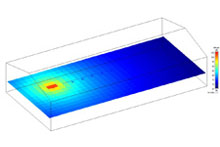In terms of noise at work, the study for solutions is a major activity for ITS: there are many opportunities to use the experience acquired by its human resource in all branches of industry, and also in the tertiary sector.
Indeed, limiting noise at work is often a common concern for employees and employers.
Employees, when they do not wish to work in a sufficiently comfortable sound environment e.g. in the case of landscaped offices, wish at least to be spared from the disastrous health effects of noise exposure, likely to generate fatigue, stress, and in some cases irreversible hearing losses.

|
Employers, some of whom may be sensitive to the wishes of employees - especially if they are expressed in a Committee for Health, Safety and Working Conditions - are (in all cases) required to do what is necessary in the company the field of regulatory constraints.
But, what then can be done ? Which solutions on can study in the event of noise at work, which one wishes to reduce and to whom can one entrust such a mission ?
In France, the higher exposure values triggering the preventive action are a daily noise exposure level of 85 dB (A) or a peak sound pressure level of 137 dB (C).
Some actions may be to reduce noise at the source e.g. by the means of production lines and equipment enclosures, machinery soundproofing of carterization, partitions and noise barriers or silencers installation.
If it is not envisaged to protect operators by the means of a cabin, a noise reduction action that does not impact the production equipment may consist, even more so if the actions mentioned above are insufficient in terms of their performance in terms of acoustics or impossible to implement e.g. because of technical non-feasibility or because of unaffordable price, to reduce the amplification of sound levels due to the reverberation of the working premises.
This action is explicitly provided for in the Decree of 30 August 1990, which in France is the reference in the field of acoustic correction of work premises and which is applicable to their construction or layout if they are the place of activities likely to expose workers to a daily sound exposure level greater than 85 dB (A), and if it is established that reverberation would cause an increase in a worker's daily sound exposure level equal to or greater than 3 dB (A).
It involves lining all or some of the surfaces reflecting the sound of absorbent materials, to reduce the effect of their presence.
In the field of noise at work, the study for solutions involves the evaluation of sound levels in different locations e.g. of a workshop, as resulting from the presence of one or more noise sources and from the physical limits of the workspace.
With regard to sound levels, mapping is, among other things, a common means of illustrating the outputs of acoustic study of a workshop.
For sound levels, sound mapping (before or after soundproofing) is, among others, a common way for ITS for illustrating some of the outputs of the study for solutions in the field of noise at work.
ITS has simulation resources for the study of solutions with respect to the problem of noise at work, allowing the consideration of different scenarios of improvement of a given situation, to which an acoustic performance and an investment amount can be associated, being evaluated by ITS (if necessary: in relation with specialized business partners). A choice can then be made by the Customer of ITS, knowingly.